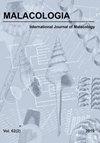镜中透视:倒转型小管Pomacea Canaliculata(壶足目,壶足科)的壳形态、解剖和交配行为
IF 1
4区 生物学
Q4 ZOOLOGY
引用次数: 0
摘要
摘要蜗牛表现出主要的左右不对称性,出现在卵子的第一次分裂过程中,其次是与外壳的卷曲有关的不对称性。大多数物种由右旋或左旋形态(对映体)组成,而具有反向初级不对称性的个体极为罕见。壶螺科的淡水蜗牛通常是右旋对映体,具有平面、高营养或正营养的外壳。由于其入侵性,人们对其进行了充分的研究,渠藻表现出右旋初级不对称和正营养生长,从而形成顺时针方向的外壳。尽管有大量的研究集中在运河粉身上,但迄今为止只有两个具有反向不对称性的标本被报道。在这里,我们报告了在阿根廷潘帕斯南部的两个种群中发现的两个活蜗牛和三个反时针盘绕的运河螺空壳。这两种逆时针方向的活蜗牛都是雄性,它们试图在实验室中与顺时针方向的雌性交配,但未能使其受精。逆时针贝壳的顶端和蜗牛的解剖结构表明,螺旋的逆转是由于左旋对映体的正营养发育。通过几何形态计量学进行的形态分析没有发现除螺旋方向外与顺时针蜗牛的其他差异。我们得出的结论是,这些逆时针蜗牛可能是像其他蜗牛物种一样,当母亲是一个隐性纯合子,可以逆转显示母亲遗传延迟的等位基因时产生的。由于逆时针个体的生殖劣势,建立具有二形态不对称的种群的机会非常低。本文章由计算机程序翻译,如有差异,请以英文原文为准。
Through the Looking-Glass: Shell Morphology, Anatomy and Mating Behavior of Reversed Pomacea Canaliculata (Caenogastropoda, Ampullariidae)
ABSTRACT Snails exhibit a primary left-right asymmetry that appears during the first cleavages of the eggs, and a secondary asymmetry, related to the coiling of the shell. Most species are constituted by either dextral or sinistral morphs (enantiomorphs) while individuals with reversed primary asymmetry are extremely rare. Freshwater snails of the family Ampullariidae are normally dextral enantiomorphs with planispiral, hyperstrophic or orthostrophic shells. Pomacea canaliculata, a well-studied species because of its invasive status, shows dextral primary asymmetry and orthostrophic growth that results in clock-wise shells. Despite the great number of studies focused on P. canaliculata, only two specimens with reversed asymmetry have been hitherto reported. Here we report the finding of two live snails and three empty shells of P. canaliculata with anti-clockwise coiling that appeared in two populations from the southern Pampas, Argentina. Both anti-clockwise live snails were males that attempted to copulate with clock-wise females in the laboratory but failed to inseminate them. The apex of anti-clockwise shells and the anatomy of the snails revealed that the reversal of coiling was due to an orthostrophic development of sinistral enantiomorphs. Morphological analysis performed through geometric morphometrics did not find other differences with clock-wise snails other than coiling direction. We conclude that these anti-clockwise snails are probably engendered, as in other snails species, when the mother is a recessive homozygote for reversing alleles that show delayed maternal inheritance. The chances of establishment of populations with dimorphic asymmetry are very low because of the reproductive disadvantages of anti-clockwise individuals.
求助全文
通过发布文献求助,成功后即可免费获取论文全文。
去求助
来源期刊

Malacologia
生物-动物学
CiteScore
2.00
自引率
0.00%
发文量
15
审稿时长
3 months
期刊介绍:
Malacologia publishes papers on all groups of the Mollusca. Malacologia specializes in publishing long papers and monographic treatments. Complete data are especially appreciated. Papers must be of interest to an international readership. Papers in systematics, ecology, population ecology, genetics, molecular genetics, evolution and phylogenetic treatments are especially welcomed. Also welcomed are letters to the editor involving papers published or issues of import to science of the day.
 求助内容:
求助内容: 应助结果提醒方式:
应助结果提醒方式:


